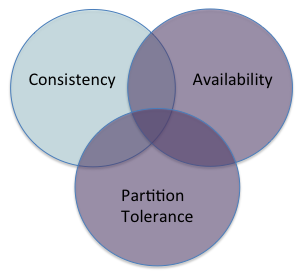Trading consistency for availability (Week 9, Friday—March 14, 2014)
Emphasizing availability when partitions occur
Source: CAP Twelve Years Later

So long as there are no network partitions (most of the time), a system can be strongly consistent and available:
-
Strongly consistent: The users cannot tell if the system is one instance or multiple instances
- Every user sees the same order of updates to a value
-
Available: Every user can do every possible operation
It won’t come free—there will still be latency costs to sustaining the illusion of a single system
-
Update messages between the instances
-
Waits for multiple synchronous writes to occur to replicas
-
Limited by the slowest instance
-
The number of write instances will typically be much smaller (1-3) than the number of compute instances we considered in large-scale computation (1000s)
-
The problem of one very slow instance remains
-
Time outs define “partitions” for a client
Every service request has a time out
-
If request does not complete within time out bound, the client must respond
-
Might retry one or more times, but when the final retry times out?
The partition decision: How your code responds to timed-out requests determines whether your system is strongly consistent or available:
-
Keep retrying (maybe with longer time out limits) until requests start working (give up availability but remain strongly consistent); or
-
Enter partition mode, continue serving the user (give up strong consistency but remain available)
Each client makes its own decision about “partition”. One client can see a partition while another client does not.
How long do we set the time out value?
-
Short (100s of ms)—we assume a failure quickly
- Induces lots of partitions
-
Long (seconds)—takes time to detect a failure
-
Longer latencies
-
Fewer partitions
-
Relaxing consistency
If we abandon the requirement that all users see the same order of updates (strong consistency), what do we gain?
-
Greater scalability
-
Lower latency
-
Partition tolerance
“Eventual consistency” is an ambiguous promise: If you stop updating the system, and wait “long enough”, the system will converge on “some value”—every user will eventually see the same value.
-
Trivially (but uselessly) achievable by returning an arbitrary value to every query (answer every question, “42”)
-
More usefully, is the application able to occasionally converge to an out of date value?
-
Or could your service return multiple values, letting the user pick the most useful one?
Those are the best you can do after a partition
-
In the general case, you cannot guarantee that your system will converge to a single, latest value
-
Some specialized operations do permit this guarantee (See CALM theorem and Converget Replicated Data Types, CRDTs)
-
But you will not be able to build a full application using only these operations
-
So you’ll have to make some hard decisions
-
Maintaining business rules and data structure invariants
An application typically has business rules it must maintain
-
A bank account cannot be negative
-
A flight cannot carry more passengers than seats
These imply invariants across your data structures
Relational database systems offer key constraints to ensure some invariants
- A Purchase record cannot be created with a nonexistent customer id
You can’t guarantee the invariants if you keep running while partitioned
But in many cases you have compensation strategies
-
Banks permit an ATM to dispense small amounts (up to $200, say) when they are cut off from the server
-
If customer overdraws, bank adds service charge
-
Airlines routinely overbook flights
-
Rare for every passenger to show up
-
If too many show up, offer free tickets to the ones willing to wait for a later flight
-
When designing for partitioned operations, which invariant violations can you compensate, which invariants must you never violate?
-
OK to send someone two copies of a book
-
Probably not OK to give patient twice their drug dosage
Guide to reading for next class
Read Distributed systems for fun and profit, Chap. 5: up to but not including “Replica synchronization: gossip and Merkle trees”.
Important points: “Eventual consistency with probabilistic guarantees”—this is the normal definition of eventual consistency.
Points not important to this course: “eventual consistency with strong guarantees” (CRDTs and CALM)—this remains a research topic, with few to no applications built using this concept.
Important section: Reconciling different operation orders